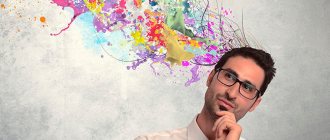Rational thinking is a standard psychological term that reflects the most abstract level of human thinking. It is otherwise called logical thinking. It doesn’t make much difference which concept to use, since they mean the same thing.
This method of intellectual activity is used to establish logical connections and sequences. Allows you to perceive the world from the point of view of reason, be critical of everything, find weak points in arguments, and approach problems in a non-standard way. This is only part of what this type of mental activity is responsible for.
Rational thinking develops much later than others. And not automatically, but under the influence of systematic activity. The more focused it is, the better the results. The development of intellectual abilities is possible at any age. As for the type under consideration, it develops most effectively in mature years. Starting from about 14-15 years old, you can actively engage in training. Previously, you only need to lay down basic skills and techniques.
What does rational thinking consist of, how to check the degree of its development in yourself, how to develop strong skills to think logically?
The concept of rationality
Before we talk about rational thinking, let's first find out what rationality means in general. The word “rationality” comes from the Latin term ratio, which translates as “reason.”
It is generally accepted that a person endowed with this quality has intelligence, prudence, logic, and practicality. He solves problems effectively and meaningfully, without giving in to emotions and feelings. A rational person can explain any situation from a logical point of view. He is only confident in what he can test and prove in practice.
Based on this knowledge, let's try to define rational thinking.
Rational thinking is a constructive thought process that is built on logical conclusions and is aimed at making decisions and achieving goals.
In simple words, we can say that this is a form of thinking based on logic. It is not subject to emotions. He is guided only by reason.
As a rule, this type of thought process is more typical for men. Although in the modern world there are many women who hold responsible positions, run their own businesses and often have excellent rational thinking.
More than 100 cool lessons, tests and exercises for brain development
Start developing
But if men rarely deviate from this type of thinking, then women can turn to their other sides: intuition, daydreaming. It is worth noting that it is this ability of the female mind that sometimes shows effectiveness in solving certain issues, since not everything can be solved with logic alone.
The structure of logical intellectual activity, as well as thinking in general, consists of such forms of rational knowledge as:
- Concept.
- Judgment.
- Conclusion.
I explain these and other terms in detail in the article on types of thinking.
Structure: What does the thought process consist of?
The process of thinking about your decisions and constructing further activities in relation to logic has a certain structure, including elements:
- A concept is the name of an object or phenomenon with which we have to interact or about which we need to make our opinion. At this stage, only the name of the object (“house”, “sister”, “sea”, etc.) or process (“flight”, “study”, “conversation”, etc.) is used. Such a presentation of the concept is necessary both for the individual himself for further analysis, and for possible listeners as a designation of the problem.
- Judgment is the process of connecting several objects designated in a concept, or finding a relationship between an object and an action (“a bird is flying,” “a sister is studying,” “a conversation at sea,” etc.). Making connections is usually like explaining or expanding information about a subject, which ultimately leads to certain conclusions.
- Inferences are conclusions obtained during the analysis and combination of judgments (for example, drawing an inference about why a bird flies or why a sister studies).
These are the basics used to solve problems of any complexity. It can even be used in everyday life, when to improve the situation it is necessary to turn off emotions and focus on logic. Such abstraction takes a lot of time and requires training to develop this skill. But it is not always possible to act this way automatically, even after years of practice, since often the emotional side is stronger.
Principles of rational thinking
Can you call yourself a rational person? Below I will give signs that will help you draw conclusions about your thinking.
So, thinking rationally is:
- Think about the future more than the past. Rational thinkers care about progress and focus on their goals and objectives, rather than on events of long ago.
- Note the pros and cons before making decisions. When you think about the consequences, you have to feel less worried.
- Always ask the reasons first. A rational person will not just do things. He will first ask himself why he needs it.
- Don't let your emotions take over your reason. Emotions can cloud your view of obvious things. When making important decisions, a rationalist will be guided by a sober assessment.
- Make plans and follow them step by step. Every task, even the simplest one, requires a clear action plan. A rational person carefully outlines the chain of achieving his goals, defines methods, and sets deadlines. With this approach, solving problems and making progress becomes easier.
- Be able to quickly find and learn new things. Rationality allows you to easily master any skill, just by devoting enough time, concentration and carefully understanding all the details. Such a person knows what methods can be used to obtain this or that information. He is not too lazy to delve into reference books and ask opinions from more experienced people.
- Keep a diary. This helps you stay organized and prevents you from forgetting about things.
- Adequately perceive and take into account other people's comments. There is no need to blindly trust the opinions of others. But in any opinion or criticism you can hear a healthy grain and use it for the benefit of your own goals.
The story of Stanislav
During my office work, I met one interesting person. A wonderful young man, Stanislav, worked in the next office. There were always legends about his achievements, and I can’t say that the stories were too exaggerated. Stanislav really always did an excellent job. Every time he was assigned a project, he delivered it in the shortest possible time, and the material was worked out to the smallest detail. Often my “miracle colleague” was entrusted with leading a team (large projects required group work).
To say that he managed the team well is an understatement. People worked as one well-coordinated mechanism, everyone understood their responsibilities, met deadlines and managed to coexist peacefully with each other. Imagine my surprise when I found out that in addition to work, he manages to build a house, raise two children, treat his mother and play several musical instruments in his free time!
Being somewhat shocked by such an amazing colleague, I decided to find out his secret. Observations from the outside did not yield any results, so I decided to ask directly how he manages to cope with all matters so quickly and well. Over a cup of coffee, Stanislav told me that back at the university he put off submitting projects and coursework until the last minute, which is why the last days before the session seemed like a living hell to him.
He recalled with horror how he worked for several nights on some project, and as a result the teacher sent it for revision, and the hell lasted for another week. Having decided that he would not last long, Stanislav realized that he needed to somehow change himself and his thinking. From another teacher, to whom he handed in his work on the last day, the unfortunate student learned about structural thinking. At first it was difficult for him to overcome the force of habit, but gradually life began to change. Studying began to be easier for Stanislav, and his free time became more and more. At first I had a hard time believing his story, but when he began to talk in detail about the principles of how structural thinking works, I really realized that changing our thinking can change our entire lives.
Historical example
In an everyday sense, rational thinking means the need to turn on a cool head, move away from emotional experiences and analyze what is happening calmly, looking at everything as if from the outside. This can be difficult to do. Especially in critical situations, when feelings go off scale and the brain refuses to think sensibly.
This problem has been recognized since ancient times. Let us recall, for example, Stoicism, an ancient philosophy that arose in Athens. Many people associate the word “stoic” with steadfastness and rock-like solidity. This teaching perfectly describes the saying from the book of thoughts of Marcus Aurelius and Seneca: “A Stoic is one who stands, even if everything around him collapses, and one who fulfills his duty to the end.”
But this quality of a Stoic is not some unique feature of personality or character. The ability not to lose your mind in the most difficult life situations can be cultivated and developed in yourself. I will give one more reflection of the great Roman emperor.
Independence and calmness before the game of chance. So that for a moment you don’t look at anything except your mind, and always be the same: in acute pain, or having lost a child, or in a long illness.
Marcus Aurelius.
The game of chance in this context is a philosophical attitude towards life. After all, everything that happens around us is nothing more than a chain of events, fate. And if we can’t control something, then why worry? If we can take control of ourselves and our attitude towards what is happening, wouldn’t the best solution be to maintain rational thinking and not give in to excessive emotions?
Of the many philosophical teachings, it is Stoicism that is closest to real everyday life. It helps you learn to make informed decisions even in difficult situations, which is the basis for rational thinking.
Thinking Errors
Before we get to the mistakes, as a preface, I would like to mention the fan fiction “Harry Potter and the Methods of Rationality”. Fanfiction is amateur writing based on famous literary works. Since 2010 and for 5 years, American artificial intelligence specialist Eliezer Yudkowsky published fan fiction based on the Harry Potter series of novels on his blog.
But what does the book wizard and the topic of our article today have to do with it? Of interest to us is how the hero of Potter's alternate reality work identifies errors in thinking using his truly canonical rational thought process.
So, now about the errors. Let's find out what factors prevent us from thinking logically:
- Attribution error. This is when a person explains the actions and behavior of other people by their personal characteristics (character), and their personal actions by external circumstances. If we behave badly, we see the reason in fatigue, the chain of unpleasant events that preceded it, etc. Why don’t we make such concessions to other people? The thing is that we do not see what events provoked this or that behavior of another person, and it is much easier for our brain to label and act according to a stereotype. The brain always chooses the thought that requires the least amount of energy.
- Planning error. It says that a person most often underestimates the time it will take to solve a problem. For example, when you are asked how long a project will be ready, you are more likely to give less time than it actually takes. There are several reasons. First, a person tends to focus on the positive scenario rather than thinking about potential obstacles. Secondly, he is prone to wishful thinking. And third, people may forget about the time they have already spent on a task in the past.
- Egocentric distortion. It is expressed in the fact that a person overestimates his point of view when looking at the events of his life or trying to put himself in the place of other people. Let me explain with an example. You did something that embarrassed you and you think that those around you will remember it for many years to come. In fact, only you will think about it, suffering and feeling shame, and other people only care about themselves, because everyone is the center of their world for themselves.
- Bystander effect. It occurs during any emergency. Studies have shown that you are more likely to receive outside help in an accident if there is one witness nearby than with three, five, or even a whole crowd. When a person becomes not the only witness, he always hopes that someone else will help the victim. And a single eyewitness understands that only he can take on this role.
- Self-deception. This is an attempt to get rid of cognitive dissonance, when a person adjusts reality to his vision of the world, i.e., to personal beliefs and ideas. Or, for example, he completely denies what he does not like or does not correspond to his opinion, refusing to test it in practice.
This is a relatively short list. We covered the topic of thinking errors in more detail in our other article.
Sensory cognition
Sensory cognition occurs through the human senses. The main mechanisms of sensory cognition: vision, hearing, smell, touch, taste.
Forms of sensory knowledge:
- Sensation is a reflection of the individual properties of an object, phenomenon, process that arise as a result of their impact on the senses. With the help of these organs, a person perceives some properties of an object - shape, color, smell.
- Perception is a sensory image of a holistic picture of an object, process, phenomenon that affects the senses. It is perception that helps form ideas.
- Representation is a sensory-visual, generalized image of an object, process, phenomenon, which is preserved and reproduced in consciousness even without the influence of the objects of knowledge themselves on the senses. In other words, what is retained in a person’s memory after becoming familiar with the subject.
Sensory cognition is always subjective, and it is this level of cognition that realizes a person’s connection with the outside world.
What is irrational thinking
Irrationalism comes from the Latin irrationalis and is translated as “unconscious, unreasonable.” Irrational thinking is the exact opposite of rational thinking.
In the broadest sense of the word, irrationalism means denial or limitation of the role of reason in understanding the world. If rational thinking is based on logic, then its antipode is based on feelings, intuition, emotions, faith, instincts.
To demonstrate examples of irrational thinking, I will give three main categories:
- Exaggeration. This is when we think something like: “They definitely didn’t like me,” “He noticed that I have low self-esteem,” etc.
- Overgeneralization. For example: “They didn’t pass this exam, which means I won’t be able to cope,” “Last time I forgot the words of the report, which means it will be the same this time,” etc.
- Mind reading. For example: “I know what you think about me” or “She thinks I’m rude,” etc.
All these thoughts are not based on any facts. This is purely human perception or, if you like, intuition.
Zeno's paradoxes
The world cannot be explained by existence, since in existence there is neither movement nor multiplicity, which seem to exist in the world. Parmenides' student, Zeno, decided to show that there is no plurality and movement in the world, and with the help of paradoxes, he tried to think things within the framework of Paramenides' concept.
The flying arrow paradox. A flying arrow flies - therefore it moves. On the other hand, a flying arrow exists - therefore, it is located in some place in space. Having determined this place, we get that the arrow is motionless. (Illustration is a derivative that is not zero.)
The paradox of the infinitely small and the infinitely large. If multiplicity exists, then each thing is infinitely small and infinitely large at the same time. Indeed, in this case, any thing can be divided an infinite number of times, and an infinitely large number of infinitesimal parts will be obtained. Since a thing consists of infinitely small parts, then it itself is infinitely small, and since a thing consists of an infinite number of parts, then it is infinitely large. Thus, any thing is infinitely small and infinitely large at the same time.
Modern science has to push these contradictions under the carpet and handle them with iron fists. (Illustration - integral, divergent harmonic series.)
Zeno discovered the paradoxes that result from allowing movement and multiplicity into the temple of strict thought. But contradictions are inherent in existence itself.
How to learn to think rationally
The formation of the foundations of rational thinking in a child is completed around the age of 12. Further, constant targeted training is required.
There are several ways to develop a logical form of thinking:
- Solve as many intellectual problems and puzzles as possible.
- Evaluate everything you read from a critical point of view. There are a lot of irrational posts and articles on the Internet with a bunch of blunders and errors. Study what you read carefully. Over time, you will be able to figure out various counter-intuitive things easily and quickly.
- Practice writing essays. You can choose a literary work or news event as a topic. Express your thoughts in detail, provide facts, justify your conclusions and express your position.
- Study materials on logic. Both simple university textbooks and more complex works may be suitable.
- Chat on different topics. It’s good if among your friends or acquaintances there are those who can support any discussion, discuss what they’ve read, understand current world news, etc.
- If you are faced with any task, write down in detail on paper point by point all the nuances, possible solutions, ideas, snags, notes and everything that comes to mind. This kind of brainstorming will help you study the situation in detail and come up with new solutions.
- Always find answers to your questions. Did you remember something and became interested in learning about it? Google it and satisfy your curiosity.
- Before making any decision, ask yourself why you think this way and whether this is really your thought and not imposed by someone else.
- Write down all your strange or negative thoughts and try to analyze them from a critical point of view.
If you are interested, I recommend reading our article about what analytical thinking is and how to develop it.
Advantages and disadvantages
Undoubtedly, rational thinking has a number of advantages. In particular:
- allows you to adequately respond to current events and not regret what you did or said in the heat of the moment;
- helps you make informed decisions without unnecessary emotions, which in certain situations simply get in the way;
- allows you to draw conclusions based on real facts, and not on personal speculation and intuition.
However, rationality also has its drawbacks. Mainly it is a low level of feeling. People with a predominant logical type of thinking may have difficulty expressing emotions and feelings, because they perceive the surrounding reality from the position of “not proven - does not exist.”
But with this approach, we must not forget that rationality is not the only way to understand the world. It is no coincidence that we are endowed with a wide range of different feelings and sensations that help solve life issues in which logic may be powerless. All artists, poets, composers have irrational thinking, which helps them create, fantasize, and reproduce images from their heads.
We can say that rational and irrational types of thinking are two sides of the same coin. For a harmonious perception of the world and full success, you need to have skills of both types.
Creation. Intuition
The human psyche acts as a constant process of developing new forms of sensory, rational and eidetic knowledge. The psyche as an activity to develop something new is spiritual creativity. The English scientist G. Wallace identified four stages of the processes of spiritual creativity: preparation, maturation, insight and verification. The central moment of creativity is insight, an intuitive grasp of the new.
Intuition is direct, unconsciously acquired knowledge. Intuitive knowledge can be sensory (contemplative), rational or eidetic. In the first case, intuition acts as an instant feeling. In the second case, we are dealing with intellectual intuition, the discussion of which occupied a prominent place in the philosophy of Descartes, Spinoza, and Leibniz. In the third case we are talking about eidetic intuition.
In philosophical movements, which are usually classified under the rubric of intuitionism (Bergson, Lossky), intuition is more a given than comprehension of the unknown. According to Lossky, the world is an organic whole, therefore there is always epistemological coordination between subject and object, even when there is no cognition. At the same time, when characterizing intuition as an act of cognition, intuitionists are not inclined to structure this act and most often emphasize the integrity of intuition. In fact, we are talking about eidetic intuition in its undivided form.
Since the ways in which intuition arises are not realized, there is a temptation to see the secret of intuition either in the depths of the unconscious (S. Freud), or, conversely, in the “superconsciousness”, under which K.S. Stanislavsky understood the highest stage of the creative process, different from both the unconscious and the conscious. But creativity and intuition are determined not only by the unconscious, but also by the conscious. This calls into question the attribution of intuition exclusively to the realm of the unconscious and irrational (i.e., inaccessible to reason).
The rapid development of the entire human sphere poses the task of teaching creativity. The science of studying creative activity and teaching methods is called heuristics. Socratic conversations, exchange of opinions, discussions, analysis of problem situations - all this contributes to the development of the spiritual and creative abilities of the individual. It is interesting to note that these abilities can be enhanced in the process of using a computer: when the construction of a system of plausible models makes it possible to more effectively search for new knowledge.
Intuition and creativity do not lend themselves to formal logical description, but there are methods, they are called heuristic, following which the search for something new is carried out, requiring the mobilization of the talent, memory, attention, and imagination of the subject. Inductive reasoning - the transfer of knowledge obtained from the study of part of the phenomena to the entire class as a whole - is a heuristic technique. Reasoning by analogy is also a striking example of heuristic reasoning, which does not guarantee the achievement of truth, but at the same time is not an arbitrary assumption. Mathematical modeling is again a heuristic technique.
Books on the topic of rational thinking
If you want to develop rationality and logic, one article on the topic and a few exercises may not be enough. For greater understanding, I recommend a selection of books:
- David Rock "Brain" Instructions for use. How to use your capabilities to the maximum and without overload” (electronic version on liters, paper version on Labyrinth).
- Keith Stanovich “Rational Thinking. What aptitude tests don’t measure” (Labyrinth).
- Eliezer Yudkowsky “Harry Potter and the Methods of Rational Thinking” (you can purchase a paper version of the book to order through the Reglet copy center website or through the official community on VKontakte).
- Richard Nisbett “Brain Accelerators” (liters).
- Joseph O'Connor, Ian McDermott “The Art of Systems Thinking. Necessary knowledge about systems and a creative approach to problem solving” (LitRes).
- Ryuta Kawashima “Japanese system for the development of intelligence and memory” (Labyrinth).
- Barbara Oakley “Think like a mathematician. How to solve any problems faster and more efficiently” (liters).
You can find even more books about thinking on the blog iklife.ru.











